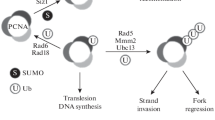Abstract.
The genomic integrity of all living organisms is constantly jeopardized by physical [e.g. ultraviolet (UV) light, ionizing radiation] and chemical (e.g. environmental pollutants, endogenously produced reactive metabolites) agents that damage the DNA. To overcome the deleterious effects of DNA lesions, nature evolved a number of complex multi-protein repair processes with broad, partially overlapping substrate specificity. In marked contrast, cells may use very simple repair systems, referred to as direct DNA damage reversal, that rely on a single protein, remove lesions in a basically error-free manner, show high substrate specificity, and do not involve incision of the sugar-phosphate backbone or base excision. This concise review deals with two types of direct DNA damage reversal: (i) the repair of alkylating damage by alkyltransferases and dioxygenases, and (ii) the repair of UV-induced damage by spore photoproduct lyases and photolyases. (Part of a Multi-author Review)
Similar content being viewed by others
Author information
Authors and Affiliations
Corresponding author
Rights and permissions
About this article
Cite this article
Eker, A.P.M., Quayle, C., Chaves, I. et al. DNA Repair in Mammalian Cells. Cell. Mol. Life Sci. 66, 968–980 (2009). https://doi.org/10.1007/s00018-009-8735-0
Published:
Issue Date:
DOI: https://doi.org/10.1007/s00018-009-8735-0




